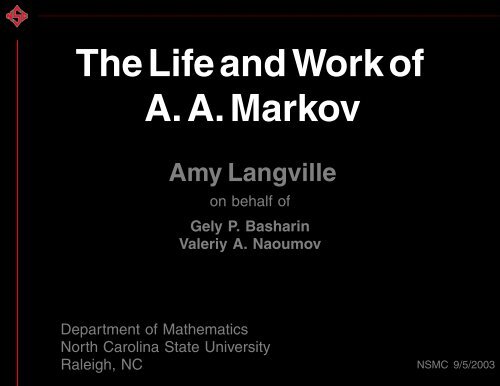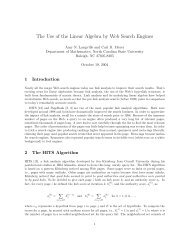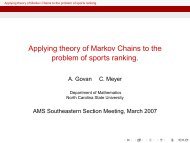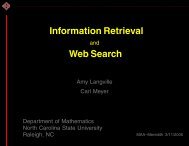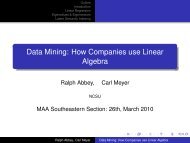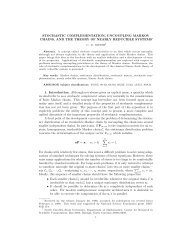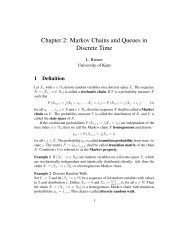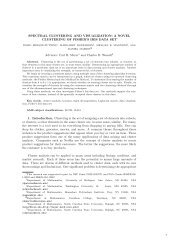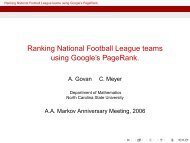The Life and Work of A. A. Markov
The Life and Work of A. A. Markov
The Life and Work of A. A. Markov
- No tags were found...
You also want an ePaper? Increase the reach of your titles
YUMPU automatically turns print PDFs into web optimized ePapers that Google loves.
<strong>The</strong><strong>Life</strong><strong>and</strong><strong>Work</strong><strong>of</strong>A.A.<strong>Markov</strong>Amy Langvilleon behalf <strong>of</strong>Gely P. BasharinValeriy A. NaoumovDepartment <strong>of</strong> MathematicsNorth Carolina State UniversityRaleigh, NC NSMC 9/5/2003
OutlineEvents before <strong>Markov</strong><strong>Markov</strong>’s Personal <strong>Life</strong><strong>Markov</strong>’s Academic <strong>Work</strong>
Roots <strong>of</strong> Prob. theory begin at AcademyRussian Firsts:• 1738 – first Russian paper on probability theory(D. Bernoulli, “Exposition <strong>of</strong> a new theory on the measurements <strong>of</strong> risk”)• 1846 – first Russian textbook on probability theory(V. Y. Bunyakovsky, “<strong>The</strong> Fundamentals <strong>of</strong> Mathematical <strong>The</strong>ory <strong>of</strong> Probability”)• 1846 – first Russian dissertation on probability theory(P. L. Chebyshev, “An Experience in an Elementary Analysis <strong>of</strong> the Probability <strong>The</strong>ory”)• 1840s–1860s – first Russian courses on probability theory taughtat St. Petersburg University(Bunyakovsy <strong>and</strong> Chebyshev)
Chebyshev’s influence on <strong>Markov</strong>’s work• 1847 – Chebyshev obtains position at St. Petersburg University• 1867 – “On Mean Values” generalized the law <strong>of</strong> large numbers• 1887 – “On Two <strong>The</strong>orems concerning Probability” generalized the CLT,presented method <strong>of</strong> moments• Kolmogorov said that(pro<strong>of</strong> <strong>of</strong> CLT by method <strong>of</strong> moments later completed by <strong>Markov</strong>)“Chebyshev was the first to estimate clearly <strong>and</strong> make use <strong>of</strong> such notions as r<strong>and</strong>omquantity <strong>and</strong> its expectation value.”
Chebyshev as a teacher• Chebyshev had an impressive list <strong>of</strong> famous students.(Sokhotsky, <strong>Markov</strong>, Lyapunov, Voronoi)• Chebyshev was renowned as a teacher. Lyapunov said,“His courses were not voluminous, <strong>and</strong> he did not consider the quantity <strong>of</strong> knowledgedelivered; rather, he aspired to elucidate some <strong>of</strong> the most important aspects <strong>of</strong> theproblems he spoke on. <strong>The</strong>se were lively, absorbing lectures; curious remarks on thesignificance <strong>and</strong> importance <strong>of</strong> certain problems <strong>and</strong> scientific methods were alwaysabundant. Sometimes he made a remark in passing, in connection with some concretecase they had considered, but those who attended always kept it in mind. Consequently,his lectures were highly stimulating; students received something new <strong>and</strong>essential at each lecture; he taught broader views <strong>and</strong> unusual st<strong>and</strong>points.”
<strong>Markov</strong>’s Academic Timeline• born on June 14, 1856 in Ryazan, Russia• early 1860s – <strong>Markov</strong>s move to St. Petersburg• 1866 – A.A. attends gymnasium – poor at all subjects exceptmathematics• “invents” new method for solution <strong>of</strong> linear differential equations.Informs Korkin <strong>and</strong> Zolotarev <strong>of</strong> his discovery, beginning lastingrelationship with the St. Petersburg pr<strong>of</strong>essors.• 1874 – graduates from gymnasium, enters St. PetersburgUniversity, takes courses from Chebyshev, Korkin, Zolotarev• most active attendee <strong>of</strong> Korkin, Zolotarev’s special home classes• 1877 – receives gold medal for research, “On the Solution <strong>of</strong> DifferentialEquations with the help <strong>of</strong> Continuous Fractions”• 1880 – Master’s <strong>The</strong>sis, “On the Binary Square Forms <strong>of</strong> the PositiveDeterminants”
<strong>Markov</strong>’s Academic Timeline (cont.)• 1880 – Associate pr<strong>of</strong>essor at St. Petersburg, teaches Analysis<strong>and</strong> Calculus. After Chebyshev retires, teaches Probability.• 1880 – Doctoral Dissertation, “On Certain Applications <strong>of</strong> the AlgebraicContinuous Fractions”• 1886 – elected as adjunct to St. Petersburg Academy <strong>of</strong> Sciences,on Chebyshev’s proposal. Extraordinary Pr<strong>of</strong>essor atSt. Petersburg University.• 1889 – read paper “On a question by D. I. Mendeleev” at Academy session.Paper contains pro<strong>of</strong> <strong>of</strong> <strong>Markov</strong> inequality for algebraic polynomials.• 1890 – extraordinary academician <strong>of</strong> Academy <strong>of</strong> Sciences• 1893 – ordinary pr<strong>of</strong>essor at St. Petersburg University• 1896 – ordinary academician <strong>of</strong> Academy <strong>of</strong> Sciences• 1900 – published “On the Calculus <strong>of</strong> Probability”(4 Russian editions, 1 translated into German)• 1905 – awarded honorary pr<strong>of</strong>essorship at St. PetersburgUniversity. Retires but continues to lecture on probability.
<strong>The</strong> Cornell Library Historical Mathematics Monographs8/27/03 4:20 PM<strong>The</strong> Cornell Library Historical Mathematics MonographsAbout the Collection Browse Collection Home Search Collection HelpDocument name: WahrscheinlichkeitsrechnungCurrent page: Page NA (image 5 <strong>of</strong> 334)Go to:page NA : Title page50%View as:Go to page: submit previous page || next pagehttp://historical.library.cornell.edu/cgi-bin/cul.math/docviewer?did=00930001&seq=5Page 1 <strong>of</strong> 2
<strong>Markov</strong> the Teacher• interested in math education, protested vigorously against the“harmful experiments carried out in that field” at most schools.• volunteers to lecture when the mathematics teacher as his son’scollege suddenly retires.• emphasizes problem-solving.• <strong>of</strong>fers additional classes on Sundays <strong>and</strong> during vacation time.• A. A. <strong>Markov</strong>, Jr. called his father’s probability lectures “faultless”.• Mathematician Gunther remarked,“I know <strong>of</strong> instances where senior students ... would attend [his lectures] for thesecond time ... [even] after they had successfully passed <strong>Markov</strong>’s course.”• <strong>Markov</strong> himself on teaching,“<strong>The</strong> alleged opinion that studies in seminars [in classes] are <strong>of</strong> the highest scientificnature, while exercises in solving problems are <strong>of</strong> the lowest [rank], is unfair.Mathematics to a considerable extent consists in solving problems, together withproper discussion can be <strong>of</strong> the highest scientific nature while studies in ... seminarsmight be <strong>of</strong> the lowest [rank].”
<strong>Markov</strong> the Political Activist• started young, his rebel tendencies appear in his school days• refused to accept tsarist honors in protest against the exclusion<strong>of</strong> writer A. M. Gorky from the Academy• 1902 – strongly disapproved <strong>of</strong> noblemen’s honorarymembership in Academy. Wrote a distasteful limerick aboutDuke Dundook’s acceptance.• maintained a very public animosity toward colleague Nekrasov,whose work he considered an “abuse <strong>of</strong> mathematics.”• 1904–1915 – wrote over 20 letters to newspapers aboutburning social <strong>and</strong> educational issues. Garnered himself thenames, “Andrew the Furious” <strong>and</strong> the “Militant Academician”.• 1907 – renounced his membership in electorate whengovernment dissolved the new Parliament.• 1912 – wrote to Most Holy Synod asking to be excommunicatedfrom Russian Orthodox Church.Synod replied, “[<strong>Markov</strong>] has seceded from God’s Church <strong>and</strong> [we] expunged himfrom the lists <strong>of</strong> Orthodox believers.”
<strong>Markov</strong> the Political Activist• Grodensky, biographer <strong>of</strong> <strong>Markov</strong>, recounts the following storyfrom the last year <strong>of</strong> <strong>Markov</strong>’s life, a time after one <strong>of</strong> the Russianrevolutions.On the 5th <strong>of</strong> March 1921 A. A. <strong>Markov</strong> communicated that on account <strong>of</strong> theabsence <strong>of</strong> footwear he is not able to attend meetings <strong>of</strong> the Academy. A fewweeks later the KUBU (Committee for Improvement <strong>of</strong> the Existence <strong>of</strong> Scientists),meeting under the chairmenship <strong>of</strong> A. M. Gorky, fulfilled the prosaic request <strong>of</strong> thefamous mathematician. Time, however, provided a colorful sequel, <strong>of</strong> sorts, to this.At the meeting <strong>of</strong> the physico-mathematical section <strong>of</strong> the Academy <strong>of</strong> Scienceon the 25th May, Andrei Andreevich announced: “Finally, I received footwear; notonly, however, is it stupidly stitched together, it does not in essence accord withmy measurements. Thus, as before, I cannot attend meetings <strong>of</strong> the Academy. Ipropose placing the footwear received by me in the Ethnographic Museum as anexample <strong>of</strong> the material culture <strong>of</strong> the current time, to which end I am ready tosacrifice it.”
<strong>Markov</strong>’s FamilyBig Family• Father (Andrei Grigorievich) married twiceFirst Wife Nadezhda – 4 sons (Andrei A.), 2 daughtersSecond Wife Anna – 1 son (Vladimir), 2 daughtersBrother Vladimir• Andrei had much in common with younger half–brother (by 15 years)• Vladimir studied mathematics at St. Petersburg• 1892 – Vladimir extended his brother’s inequality for polymonialsto consider all derivatives• 1897 – died at age 25 <strong>of</strong> tuberculosis• Andrei completed <strong>and</strong> published Vladimir’s unfinished master’sthesis in 1897Young Andrei• used crutches due to severe inborn deformity <strong>of</strong> knee• has a knee operation at age 10 <strong>and</strong> afterwards walks withjust a slight limp
<strong>Markov</strong>’s Personal Timeline• 1856 – born on June 14 in Ryazan, Russia• 1883 – marries Maria Valvatieva, whom he had tutored in math• considered to be one <strong>of</strong> the best chess players in St. Petersburg• 1903 – son, Andrei Andreevich <strong>Markov</strong>, Junior, born(renowned mathematician in fields <strong>of</strong> logic <strong>and</strong> algebra)• 1922 – dies on July 20 at age 66 <strong>of</strong> bacterial infection in theblood caused by the last <strong>of</strong> his many leg operations on ananeurysm in his leg. Buried in Mytrophany Cemetry in St.Petersburg.
<strong>Markov</strong>’sMathematical<strong>Work</strong>onChains
PrehistoryUrn problems (Laplace, D. Bernoulli, Ehrenfests, Laplace)Brownian motion (Bohlmann)Extinction <strong>of</strong> familiesR<strong>and</strong>om walks like gambler’s ruin (Buniakovsky)Stock exchange (Bachelier)Card games, gas mixture models (Poincare)• Apparently, unrecognized by <strong>Markov</strong> (Nov. 11, 1910 letter to Chuprov)“I most humbly beg you to point out to me those articles <strong>of</strong> Bohlmann <strong>and</strong> Bachelier towhich you refer. Up to now I had thought that I was the first to dwell on the application<strong>of</strong> the law <strong>of</strong> large numbers to dependent variables...”• After reading these articles, finds his work more general <strong>and</strong>correct (Nov. 15, 1910 <strong>and</strong> Nov. 18, 1910 letters to Chuprov)Nov. 15: “I, <strong>of</strong> course, have seen Bachelier’s article but strongly dislike it. I do notattempt to judge its significance for statistics but with respect to mathematics, it has noimportance in my opinion. In any case, it does not contain an extension <strong>of</strong> Bernoulli’stheorem to dependent variables.”Nov. 18: “<strong>The</strong> cases I indicated are NOT included in Bohlmann’s cases, but containthem as special cases. <strong>The</strong>re is a huge difference. I am prepared to admit thatBohlmann gave an elegant special formula, but he did not point out even one new (aftermy article) case <strong>of</strong> the generalization <strong>of</strong> Bernoulli’s theorem.”
<strong>The</strong> Chain Gang<strong>The</strong> Concept <strong>of</strong> Chains – developments <strong>of</strong> predecessors1738 Jacob Bernoulli, “Ars Conject<strong>and</strong>i” WLLN for sequences <strong>of</strong> independentbinary r.v. X 1 , X 2 ,..., X n ,...P(X i = 1) = p <strong>and</strong> P(X i = 0) = q1837 Simeon Poisson, “Recherches sur la Probablilite des Jugements en Matiere Criminelleet en Metiere Civile” generalized Bernoulli’s theorem to includeP(X i = 1) = p i <strong>and</strong> P(X i = 0) = q i1867 Pafnuty Chebyshev, “On Mean Values” generalized WLLN to anysequence <strong>of</strong> independent r.v. with bounded second moments1898 P. A. Nekrasov, “General properties <strong>of</strong> independent events in connection with theapproximate computation <strong>of</strong> functions <strong>of</strong> very large numbers,”erroneously claims that “independence is a necessary condition for thelaw <strong>of</strong> large numbers”.1900 Andrei A. <strong>Markov</strong>, “Ischislenie veroyatnostej” further generalized WLLN tocase when variances do not exist but all moments are bounded
<strong>The</strong> Missing Link• <strong>Markov</strong> wanted to relax the independent r.v. assumption• began studying certain types <strong>of</strong> dependent r.v.• considered sequences <strong>of</strong> dependent r.v. whose dependencetrails <strong>of</strong>f as the sequence extends.
<strong>The</strong> Missing Link• <strong>Markov</strong> wanted to relax the independent r.v. assumption• began studying certain types <strong>of</strong> dependent r.v.• considered sequences <strong>of</strong> dependent r.v. whose dependencetrails <strong>of</strong>f as the sequences extends.<strong>and</strong> the CHAIN appeared!
<strong>The</strong> Missing Link<strong>The</strong> Concept <strong>of</strong> Chains – developments <strong>of</strong> predecessors• <strong>Markov</strong> wanted to relax the independent r.v. assumption• began studying certain types <strong>of</strong> dependent r.v.• considered sequences <strong>of</strong> dependent r.v. whose dependencetrails <strong>of</strong>f as the sequences extends.<strong>and</strong> the CHAIN appeared!BORN-ON DATE: 1906, “Extension <strong>of</strong> the law <strong>of</strong> large numbers to dependent variables”Term MARKOV CHAIN debuts: 1926, Bernstein
<strong>Markov</strong>’s Definitions for ChainsSimple Chain“an infinite sequence X 1 , X 2 ,..., X k , X k+1 ,... <strong>of</strong> variables connected insuch a way that X k+1 for any k, is independent <strong>of</strong> X 1 , X 2 ,..., X k−1 whenX k is known.”(1906, 1907 papers)Homogeneous Chainif conditional distributions <strong>of</strong> X k+1 given X k are independent<strong>of</strong> time k.Complex Chain“if every number is directly connected, not with a single, but with several precedingnumbers”.
<strong>Markov</strong>’s <strong>The</strong>orems for Chains1906considered MCs with P > 0 <strong>and</strong> proved ergodic theorem <strong>of</strong> MCs(Independent <strong>of</strong> the initial distribution, chain converges to limiting, stationary distribution.)For ergodic chain, ρ(P) = 1, all other λ i < 1.1908dropped P > 0 <strong>and</strong> begins to clarify what we call irreducible chains“we consider only those chains X 1 , X 2 ,..., X n ,... where [the appearance <strong>of</strong>]some <strong>of</strong> the numbers...does not finally rule out the possibility <strong>of</strong> appearing others.”(all states are reachable from all others)His condition for irreducibility: “the determinant [<strong>of</strong> P] cannot be transformedinto the product <strong>of</strong> several determinants <strong>of</strong> the same type.”(no symmetric permutation can transform P into block form,[X Y0 Z])
Chains, WLLN, <strong>and</strong> the CLTWLLN (1906)• <strong>Markov</strong> used a 2-state MC (0 <strong>and</strong> 1) <strong>and</strong> Chebyshev’s inequalityto prove that the WLLN applies to his r.v. with <strong>Markov</strong>dependence.• concluded that “the independence <strong>of</strong> variables does not produce the necessarycondition for the validity <strong>of</strong> the law <strong>of</strong> large numbers.”CLT (1907-1911)• used the method <strong>of</strong> moments from Chebyshev to prove that theCLT can be applied to his chains.
<strong>Markov</strong>’s Extensions to his Chains1910 studies simple 2-state nonhomogeneous chain, “Investigation <strong>of</strong> thegeneral case <strong>of</strong> trials connected in a chain”1911 studies complex homogeneous chains with dependence onpreceding two states, can’t establish ergodic property1913 publishes 3 rd edition <strong>of</strong> his book, “<strong>The</strong> Calculus <strong>of</strong> Probabilities”– adds work from 1906-1913 on chains– “Let us finish the article <strong>and</strong> the whole book with a good example <strong>of</strong> thedependent trials, which approximately can be regarded as a simple chain.”
<strong>Markov</strong>’s Extensions to his Chains1910 studies simple 2-state nonhomogeneous chain, “Investigation <strong>of</strong> thegeneral case <strong>of</strong> trials connected in a chain”1911 studies complex homogeneous chains with dependence onpreceding two states, can’t establish ergodic property1913 publishes 3 rd edition <strong>of</strong> his book, “<strong>The</strong> Calculus <strong>of</strong> Probabilities”– adds work from 1906-1913 on chains– “Let us finish the article <strong>and</strong> the whole book with a good example <strong>of</strong> thedependent trials, which approximately can be regarded as a simple chain.”<strong>The</strong> Famous First Application <strong>of</strong> <strong>Markov</strong> ChainstoA. S. Pushkin’s poem “Eugeny Onegin”
A.S.Pushkin. Eugeny Onegin (1-3 chapter)8/27/03 4:35 PMA.S.Pushkin. Eugeny Onegin (1-3 chapter) : ?? ????? Send?????????? go---------------------------------------------------------------© Copyright english translation Dennis LitoshickEmail: dennis_ru@hotmail.comWWW: http://zhurnal.lib.ru/l/litoshik_d_n/---------------------------------------------------------------* CHAPTER IIMy uncle was a man <strong>of</strong> virture,When he became quite old <strong>and</strong> sick,He sought respect <strong>and</strong> tried to teach me,His only heir, verte <strong>and</strong> weak.He had the fun, I had the sore,But grecious goodness! what a bore!To sit by bedplace day <strong>and</strong> night,Not doing even step aside,And what a cheep <strong>and</strong> cunning thingTo entertain the sad,To serve around, make his bed,To fetch the pills, to mourn <strong>and</strong> grim,To sigh outloud, think along:`God damn old man, why ain't you gone?' , , . ;, , ! , , , : !IISo thought a playboy, young <strong>and</strong> funny,While riding through the dust <strong>of</strong> road,<strong>The</strong> only heir to the money,That got his folks with help <strong>of</strong> Lord.http://www.kulichki.com/moshkow/LITRA/PUSHKIN/ENGLISH/litoshik.txt , , . ! Page 1 <strong>of</strong> 65
Original: (english translation, all special characters except space removed, converted to small case):my uncle a most worthy gentlemanwhen he fell seriously illconstrained everyone to respect himcouldnt have done better if he triedhis behaviour was a lesson to us allbut god above what crushing boredomto sit with the malingerer night <strong>and</strong> daynot moving even one footstep awaywhat demeaning hypocrisyto amuse the halfdead codgerto fluff up his pillows <strong>and</strong> thenmournfully to bring him his medicineto think to oneself <strong>and</strong> to sighwhen the devil will the old rascal dieso thought our young neerdowellflying through the dust on a mail coachby the supreme will <strong>of</strong> zeushe was the inheritor <strong>of</strong> all his kingood friends <strong>of</strong> ludmilla <strong>and</strong> ruslanwith the hero <strong>of</strong> my romanceallow me to make you acquainted ...Top left corner <strong>of</strong> doublet count matrix:a b c d e f . .a 1 23 26 58 4 2b 16 1 0 0 51 0c 31 0 4 0 73 0d 36 0 2 7 76 0e 123 2 23 118 63 14f 31 0 0 2 38 17..Top left corner <strong>of</strong> stochastic matrix:a b c d e f . .a 0.001 0.021 0.023 0.052 0.004 0.002b 0.081 0.005 0.000 0.000 0.259 0.000c 0.092 0.000 0.012 0.000 0.217 0.000d 0.056 0.000 0.003 0.011 0.119 0.000e 0.070 0.001 0.013 0.068 0.036 0.008f 0.083 0.000 0.000 0.005 0.102 0.046..R<strong>and</strong>om text generated by <strong>Markov</strong> chain:abomy in tyoworeadshe ieablllothinear tim s wifon cow ondow<strong>and</strong> abules ture in sethioriffour sshincore buspidre tome ifound ry ien antha winglysth f nd the a ncik othted f fle ttoulead thapagousud conghinshe r che i areravelveg ornot tourig m dettonge ots bow ouco freed tyondevinglerolisps tul ad mo ausp<strong>and</strong>o mserin lisuriasetlurisy wigld wichare toutais ddethent tlouteunde anonlend be t s hthules ad iem ded adch he tly hean hesms itaoureli<strong>and</strong> te ppsushis atrues amby f hilell avecol t chasere alembow cotr itrever morericoman<strong>of</strong>fevetthin om ...
Calculations for “Eugeny Onegin”“<strong>The</strong> second question concerns an original statistical investigation which I have carried out<strong>and</strong> with which I propose to conclude my book. <strong>The</strong> character <strong>of</strong> the investigation, whichembraces a sequence <strong>of</strong> 20,000 letters, is shown in the example below.”stationary probability <strong>of</strong> vowel = .432stationary probability <strong>of</strong> consonant = .568probability <strong>of</strong> a vowel following a vowel = .128probability <strong>of</strong> a vowel following a consonant = .663Besikovitch on <strong>Markov</strong>’s book:(Jan. 15, 1913 letter to Chuprov)“great attention is paid to the simplest numerical examples which are discussedin unusual detail. And further, it is hardly possible to find a single mistake in theseexamples.”<strong>Markov</strong> on calculating:“Many mathematicians apparently believe that going beyond the field <strong>of</strong> abstractreasoning into the sphere <strong>of</strong> effective calculations would be humiliating.”Table for Normal Distributionproduced a table with up to 11 digits. Table was used into the 1940s.
A. A. <strong>Markov</strong> <strong>and</strong> A. A. Chuprov• corresponded between 1910 <strong>and</strong> 1917, over 100 letters werefound, Chuprov’s letters from 1912, 1913, 1915 were lost• both lived in St. Petersburg. Fortunate for us, they wrote ratherthan met, or phoned.• wrote every 2-3 days in beginning, monthly later• Chuprov taught at Petersburg Polytechnic Institute, wrote book“Essays on the <strong>The</strong>ory <strong>of</strong> Statistics”, 1909• discuss proper citation <strong>and</strong> attribution <strong>of</strong> earlier contributors,banter about scientific merit <strong>and</strong> correctness <strong>of</strong> prob./stat.texts <strong>of</strong> day, edit each other’s papers <strong>and</strong> editions <strong>of</strong> books.• <strong>Markov</strong> writes, “[this] correspondence had some influence on the first chapter<strong>of</strong> my book.”(Dec. 8, 1912 letter to Chuprov)• plan <strong>and</strong> participate in Bicentennial Celebration <strong>of</strong> LLN, honoringJ. Bernoulli, “Ars Conject<strong>and</strong>i”, 1713, held on Dec. 3, 1913.
Best OR/MS in past millennium(INFORMS President John Birge)
Best OR/MS in past millennium(INFORMS President John Birge)5. Dantzig’s Linear Programming
Best OR/MS in past millennium(INFORMS President John Birge)4. Queueing <strong>The</strong>ory <strong>and</strong> Erlang’s application to phone industry5. Dantzig’s Linear Programming
Best OR/MS in past millennium(INFORMS President John Birge)3. A. A. <strong>Markov</strong>’s chains4. Queueing <strong>The</strong>ory <strong>and</strong> Erlang’s application to phone industry5. Dantzig’s Linear Programming
Best OR/MS in past millennium(INFORMS President John Birge)2. Fred Taylor’s Scientific Management for workplace3. A. A. <strong>Markov</strong>’s chains4. Queueing <strong>The</strong>ory <strong>and</strong> Erlang’s application to phone industry5. Dantzig’s Linear Programming
Best OR/MS in past millennium(INFORMS President John Birge)1. Newton <strong>and</strong> Leibnitz’s Calculus2. Fred Taylor’s Scientific Management for workplace3. A. A. <strong>Markov</strong>’s chains4. Queueing <strong>The</strong>ory <strong>and</strong> Erlang’s application to phone industry5. Dantzig’s Linear Programming
REFERENCES1. J. Bernoulli, Ars Conject<strong>and</strong>i, Opus Posthumum, Accedit Tractatus de Seriebus infinitis, et EpistolaGallice scripta de ludo Pilae recticularis, Basileae, 1713 (Ch. 1-4 translated into English by B. Sung, ArsConject<strong>and</strong>i, Technical Report No. 2, Dept. <strong>of</strong> Statistics, Harvard University, 1966).2. D. Bernoulli, Specimen theoria novae de mensura sortis, Commentarii Academiae Scientiarium ImperialisPetropolitanae, Petropoli, t. 5, 1738, 175-192 (Translated into English by L. Sommer, Exposition <strong>of</strong> a newtheory on the measurements <strong>of</strong> risk, Econometrica, v.22, 1954, 23-36).3. S.-D. Poisson, Recherches sur la Probabilité des Jugements en Matiere Criminelle et en Metière Civile,Précédées des Regles Générales du Calcul des Probabilitiés, Paris, Bachelier, Imprimeur-Libraire pour lesMathematiques, 1837.4. P.L. Chebyshev, On Mean Values, J. Math. Pure. Appl., vol. 12, 1867, 177-184.5. A.A. <strong>Markov</strong>, Ischislenie veroyatnostej, SPb, 1900; 2-e izd., SPb, 1908, Translated into German,Wahrscheinlichkeits-Rechnung, Teubner, Leipzig-Berlin, 1912; 3-e izd., SPb, 1913; 4-e izd., Moskva, 1924.6. A.A. <strong>Markov</strong>, Rasprostranenie zakona bol’shih chisel na velichiny, zavisyaschie drug ot druga, IzvestiyaFiziko-matematicheskogo obschestva pri Kazanskom universitete, 2-ya seriya, tom 15, 9 4, 1906, 135-156.7. A.A. <strong>Markov</strong>, Issledovanie zamechatel’nogo sluchaya zavisimyh ispytanij, Izvestiya Akademii Nauk, SPb,VI seriya, tom 1, 9 3, 1907, 61-80 (Translated into French, Recherches sur un cas remarquable d’epreuvesdependantes, Acta mathematica, Stockholm, 33, 1910, 87-104).8. A.A. <strong>Markov</strong>, Rasprostranenie predel’nyh teorem ischisleniya veroyatnostej na summu velichin svyazannyhv cep’, Zapiski Akademii Nauk po Fiziko-matematicheskomu otdeleniyu, VIII seriya, tom 22, 9 9, 1908.9. A.A. <strong>Markov</strong>, Issledovanie obschego sluchaya ispytanij, svyazannyh v cep’, Zapiski Akademii Nauk poFiziko-matematicheskomu otdeleniyu, VIII seriya, tom 25, 9 3, 1910.10. A.A. <strong>Markov</strong>, Ob odnom sluchae ispytanij, svyazannyh v slozhnuyu cep’, Izvestiya Akademii Nauk, SPb,VI seriya, tom 5, 9 3, 1911, 171-186.11. A.A. <strong>Markov</strong>, Ob ispytaniyah, svyazannyh v cep’ ne nablyudaemymi sobytiyami, Izvestiya Akademii Nauk,SPb, VI seriya, tom 6, 9 8, 1912, 551-572.12. A.A. <strong>Markov</strong>, Primer statisticheskogo issledovaniya nad tekstom “Evgeniya Onegina”, illyustriruyuschijsvyaz’ ispytanij v cep’, Izvestiya Akademii Nauk, SPb, VI seriya, tom 7, 9 3, 1913, 153-162.13. B. Hostinsky, Sur les probabilités des phénomenes liés en chaine de Mark<strong>of</strong>f, Compte Rendus de l’Académiedes Sciences, Paris, 189, 1929, 78-80.14. A.M. Lyapunov, Zhizn’ i trudy P. L. Chebysheva, in: P. L. Chebyshev, Izbrannye matematicheskie trudy,Gostehizdat, M.-L., 1946.Publications on A. A. <strong>Markov</strong>’s <strong>Life</strong> <strong>and</strong> <strong>Work</strong>1. ”<strong>Markov</strong> (Andrej Andreevich)”, E’nciklopedicheskij slovar’, Izd. F. A. Brokgauz, I. A.Efron, T. XVIII A, 36, SPb, 1896, 658-659.2. ”<strong>Markov</strong>, Andrej Andreevich”, Biograficheskij slovar’ pr<strong>of</strong>essorov i prepodavatelej S.—Peterburgskogo universiteta za istekshuyu tret’yu chetvert’ veka ego suschestvovaniya,1869-1894. T. 2-j. M.-Ya., SPb, 1898, 3-5.3. ”Markow Andrei Andrejewitsch”, in: J.C. Poggendorff, Biographisch-literarischesH<strong>and</strong>worterbuch, Bd. III, Lpz., 1898, S.873; Bd. IV, Lpz., 1904, S. 961; Bd. V, Lpz.—Brl.,
20 G. P. BASHARIN, A. N. LANGVILLE, AND V. A. NAOUMOV1926, S. 808; Bd. VI, <strong>The</strong>il 3, Lpz.-R.Brl., 1938, S. 1652 - 1653.4. ”<strong>Markov</strong>, Andrej Andreevich (Avtobiografiya)”, Materialy dlya biograficheskogo slovaryadejstvitel’nyh chlenov Akademii Nauk, ch. 2-ya, M.-Ya., PG, 1917, 16-18.5. ”<strong>Markov</strong>, Andrej Andreevich”, V kn.: S. A, Vengerov, Istochniki slovarya russkihpisatelej, t. IV, Lonachevskij - Nekrasov, Pg., 1917, 182.6. V.A. Steklov, Andrej Andreevich <strong>Markov</strong>, (Nekrologicheskij ocherk), Izvestiya. RossijskojAkademii Nauk, t. XVI, 9 1-18, 1922 (1924), 169-184.7. A.S. Bezikovich, Raboty A. A. <strong>Markov</strong>a po teorii veroyatnostej, Izvestiya RossijskojAkademii Nauk, t. XVII, 9 1-18, 1923, 45-52.8. N.M. Gyunter, O pedagogicheskoj deyatel’nosti A. A. <strong>Markov</strong>a, Izvestiya RossijskojAkademii Nauk, t. XVII, 9 1-18, 1923, 35-44.9. ”<strong>Markov</strong>, Andrej Andreevich (1956 - 1922)”, in: Malaya Sovetskaya E’nciklopediya, tom4, 1930, stlb. 882.10. A. N. Kolmogorov, <strong>Markov</strong> Andrej Andreevich, in: Bol’shaya Sovetskaya E’nciklopediya,tom 38, 1938, stlb. 152 - 153.11. S.N. Bernshtejn, Peterburgskaya shkola teorii veroyatnostej. Uchenye zapiskiLeningradskogo gosudarstvennogo universiteta, seriya matematicheskih nauk, 955, vyp.10, 1940, 3-11.12. B.V. Gnedenko, Ocherki po istorii matematiki v Rossii, OGIZ, M.-L., 1946.13. N. I. Ahiezer, Russkij matematik A. A. <strong>Markov</strong>, K 25-letiyu so dnya smerti, Priroda, L.,98, 1947, 76-81.14. B.N. Delone, Peterburgskaya shkola teorii chisel. M.-L., Izd. AN, 1947.15. A.A. <strong>Markov</strong>, Izbrannye trudy po teorii nepreryvnyh drobej i teorii funkcij, naimeneeuklonyayuschihsya ot nulya (ed. N. I. Ahiezer), Gos. izd. tehniko-teoreticheskoj literatury,M.-L. 1948.16. B.V. Gnedenko, Razvitie teorii veroyatnostej v Rossii, Tr. Instiyuya istoriiestestvoznaniya, t. II, 1948, 390-425.17. A.A. <strong>Markov</strong>, Izbrannye trudy. Teoriya chisel. Teoriya veroyatnostej (ed. Yu. V. Linnik),Izd. AN SSSR, 1951.18. B.V. Gnedenko, Andrej Andreevich <strong>Markov</strong> (1856-1922), Lyudi russkoj nauki: Ocherkio vydayuschihsya deyatelyah estestvoznaniya i tehniki, M., 1961, 193-199.19. A.P. Youschkevitch, Andrei Andreevich <strong>Markov</strong>, in: C.C. Gillispie (ed.) Dictionary <strong>of</strong>Scientific Biography, Scribner, New York, v. 4, 1974.20. E.P. Ozigova, Perepiska T. Stieltjesa i A.A. <strong>Markov</strong>a, Voprosy Istorii Estestvoznanija iTehniki, No. 3-4, 1977, 43-46.21. <strong>The</strong> Correspondence Between A.A. <strong>Markov</strong> <strong>and</strong> A.A. Chuprov on the <strong>The</strong>ory <strong>of</strong>Probability <strong>and</strong> Mathematical Statistics, Springer Verlag, Berlin, 1981.22. ”Andrei Andreevich <strong>Markov</strong> (1856-1922)”, Matematika v Shkole, No.1,1982.23. S.Ya. Grodzenskii, Andrei Andreevich <strong>Markov</strong>, 1856-1922, Nauka, Loskva, 1987.24. O.B. Sheynin, A.A. <strong>Markov</strong>’s <strong>Work</strong> on Probability, Archive for History <strong>of</strong> Exact Science,v. 39, 1988, 337-377.25. O.B. Sheynin, Errata for the contribution: ”A.A. <strong>Markov</strong>’s work on probability”, Archivefor History <strong>of</strong> Exact Science, v. 40, No. 4, 1989, 387.


